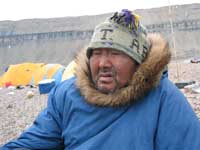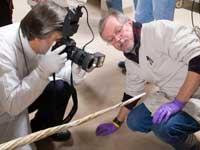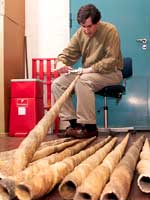Narwhal Tusk Research
Dr. Martin Nweeia, from the Harvard School of Dental Medicine, initiated the Narwhal Tusk Research project in 2000. It is a broad based, interdisciplinary, and cross cultural investigation to solve one of nature’s most perplexing mysteries. Today, more than 60 scientists have joined the effort to explore the secrets of the narwhal’s mysterious tusk. This project integrates Inuit Qaujimajatuqangit, or traditional knowledge, with interdisciplinary studies of science to enable a more comprehensive understanding of the narwhal and the sensory capabilities of its extraordinary tusk.
In addition to conducting laboratory and field studies directly investigating the physical and dental properties of the narwhal tusk, Nweeia conducted 7 field expeditions and collected 55 interviews from Inuit community members. Together, they investigate a fascinating marine mammal that is important to the Inuit who revere its place in their shared environment.
Why do tusks break?

Traditional knowledge: Inuit observations describe narwhals that are threatened or frantic and immediately dive in shallow waters, hitting the bottom and breaking their tusks against the ocean floor. This same behavior occurs when killer whales threaten an area as they hunt narwhals. Elders describe “tusking” behavior as a delicate rubbing movement and they seldom observed aggressive contact or behavior.

Science: Estimates of broken tusks in the scientific literature range from 6 percent (Gerson and Hickie, 1985) to 30 percent (Silverman and Dunbar, 1980). Many studies report aggressive male tusk use when vying for a mate (“tusking behavior”) or in defense against predators (Buckland, 1882; Gray, 1889; Freuchen, 1935; Breummer, 1966; Ford 1986).
Does the tusk bend?

Traditional knowledge: Inuit observations of living narwhals document tusk flexibility of extraordinary magnitude. Hunters describe one of the traditional uses of the tusk is to help pry a sledge from the ice.

Science: References in the literature describe very little about flexibility of the narwhal tusk. Collaborators at the National Institute of Standards and Technology have recently documented structural characteristics of the narwhal tusk that indicate a remarkably flexible and strong structure. Initial reconstruction data describes a six-foot tusk having an overall bending flexibility, from its base to the tip, of one foot in all directions. Results of these findings were submitted to the International Journal of Dental Research for publication in 2005.
How did the narwhal get its name?

Traditional knowledge: In Inuktitut, the narwhal is described as qilalugaq qernertaq, which translates to the “one that is good at curving itself toward the sky.” Narwhal can curve their back dramatically when diving downward and likewise can curve their head upward when lying on their back with their tusk pointed straight toward the sky.

Science: According to most references, the word narwhal in western culture is derived from the old norse word, naar, meaning cadaver or corpse, thus the translation to corpse-like whale. A lesser known interpretation comes from the old norse, nafarr, referring to the corkscrew which describes the spiraled tusk. Kings and emperors used a powder ground from the tusk on their food and in their wine as an antidote to poisons. Danish lore, however, indicated that the body would assume a corpse-like state if the meat was ingested.
What determines the shape of the tusks?

Traditional knowledge: The Inuit are detailed in their descriptions of the various expressions of tusk shape and form in relation to adult classification. For example, the tusks of females are described as thinner, shorter, and more evenly and tightly spiraled. Morphology of the tusk in different narwhal populations has also been noted and may characterize populations from different geographical regions.

Science: Scientific investigators have only briefly described narwhal tusk morphology, commenting about different expressions, but with no correlations to anatomic variation among adult narwhal.
Are there variations among narwhal?

Traditional knowledge: Within Canadian Inuit culture, there are several words to describe adult narwhal. These terms are also used by Greenlandic Eskimo.
- Adult narwhal: tiggar
- Female with tusk: arningali
- Female and male without tusk: tuugaittuq
- Male with white color: qakuyuktuq
- Male with black color: qinnijuktuq
- Male with long tusk and black: tuujrinnirsait
- Male with shorter and wider tusk: tuugaitun
- Double tusked the same size tusks: iglugiit
- The left tusk is longer than the right tusk: nikingaj ut

Science: The Encyclopedia of Marine Mammals (Academic Press, 2002) describes the adult narwhal as “completely mottled on the dorsum [back] but with increasing white fields on the ventral [front] side. Old adult males only maintain a narrow dark-spotted pattern on the top of the back, whereas the rest of the body is white.” Additional descriptions of the anatomic variation are similar.
References
Breummer, F. 1966. Narwhal. Fabled unicorn of Canada's Arctic seas. Star Weekly, 12 March, pages 8-11.
Buckland, F. 1882. Notes and Jottings from Animal Life. London: Smith, Elder.
Ford, D. 1986. Narwhal: Unicorn of the Arctic Seas. National Geographic, March 1986, pages 354-63.
Freuchen, P. 1935. Mammals. Part II. Field notes and biological observations. Report of the Fifth Thule Expedition, 1921-1924 2(4-5): 68-278.
Gerson, H. B., and J. P. Hickie. 1985. Head scarring on male narwhals (Monodon monoceros): Evidence for aggressive tusk use. Canadian Journal of Zoology 63: 2,083-2,087.
Gray, R. 1889. Notes on a voyage to the Greenland Sea in 1888. Zoologist 13: 1-9, 41-51, 95-104.
Perrin, W. F., B. Wursig, and J. G. M. Thewissen (eds). 2002. Encyclopedia of Marine Mammals. Academic Press.
Silverman, H. B., and M. J. Dunbar. 1980. Aggressive tusk use by the Narwhal (Monodon monoceros L.). Nature 284: 57.

